Antinol® Latest Studies
Sorted by recent
 Filter Studies by Smart Tags
Filter Studies by Smart Tags
Bone & JointCardiovascularCase Study & ProceedingCatDogEAB 277™EfficacyExotic PetImmunologyNeuro & BehaviorOphthalmologyOralRabbitRenalRespiratoryRodentSafetySkinUTI
Smart Search
Safety study of polyunsaturated fatty acids extracted from New Zealand green lipped mussel and krill on hematology and blood chemistry profiles of healthy

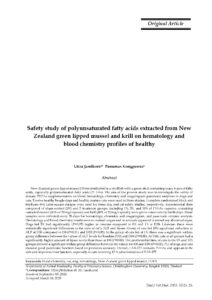
Abstract
New Zealand green-lipped mussel (Perna canaliculus) is a shellfish with a green shell containing many types of fatty acids, especially polyunsaturated fatty acids (PUFAs).
The aim of the present study was to investigate the safety of dietary PUFAs supplementation on blood hematology, chemistry and coagulogram pancreatic enzymes in dogs and cats. Twelve healthy beagle dogs and healthy mature cats were used in these studies. Complete randomized block and triplicate 4×4 Latin square designs were used for these dog and cat safety studies, respectively. Experimental diets composed of sham control (0X) and 3 treatment groups, including 1X, 3X, and 10X of PUFAs capsules containing extracted mussel (60% or 30 mg/capsule) and krill (40% or 20 mg/capsule), were given consecutively for 56 days.
Blood samples were collected every 28 days for hematology, chemistry and coagulogram, and pancreatic enzyme analysis. Hematology and blood chemistry results were in normal ranges and no animals appeared to reveal any abnormal signs.
Dogs fed 3X had significantly (P<0.05) higher in creatine compared to 0X and 1X at D28. Likewise, there were statistically significant differences in the time of cat’s ALT and lipase. Group of cats fed 10X significant reduction in ALT at D56 compared to D0 (P<0.01) and D28 (P<0.05).
In the group of cats fed at 1X, there was a significant within-group difference between the values of ALT levels for baseline (D0) and D56 (P<0.05). At D56, cats in all groups had a significantly higher amount of lipase levels than those at D0 (P<0.05). The prothrombin time of cats in the 0X and 10X groups showed a significant within-group difference between the values for D0 and D56 (P<0.05). PLI of dogs and cats showed good pancreatic function based on precision accuracy.
Overall, EAB-277 contains PUFAs and appears to be safe and improves liver function, especially in cats receiving 10 X administration of EAB-277.
Keywords: blood chemistry, cat, dog, hematology, New Zealand green lipped mussel, PUFA

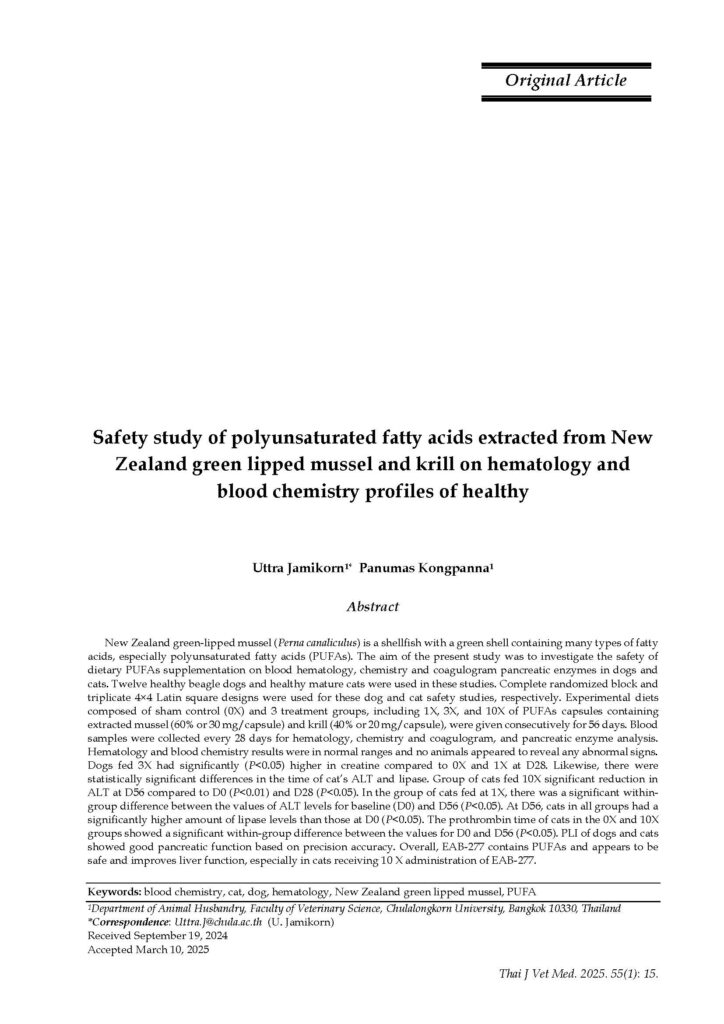
Antinol® EAB-277® – The Executive Summary

Antinol® Rapid is a potent synergistic blend of 2 marine lipid extracts chosen for their unique enhancement formula called EAB-277®.
EAB-277® is the key active ingredient of this advanced formula formulated to promote optimal benefits through its synergistic efficacy contains > 90 free fatty acids full spectrum of Omega 3 including ETA, EPA, DHA as well as other key Polyunsaturated fatty acids (PUFAs) and antioxidants.
The two marine lipids used in Antinol® Rapid are proprietary and exclusively produced. The exact combination of 30mg lipid fractions from Perna canaliculus (New Zealand green lipped mussel) and 20mg high phospholipid krill oil is the result of years of research combining and isolating lipid groups and essential fatty acids to find the optimal nutrient synergy.
EAB-277®’s proprietary high phospholipid krill oil is high in polar lipid enrichment which enhances bioactivity “Potency” of this marine oil blend formula as a result of proven efficacy.
The Antinol® Rapid EAB-277® blend has been proven via laboratory tests to be more effective than either of the individual lipids alone in inhibiting inflammation markers such as nitric oxide, TNFα, and IL-6.



PCSO-524® in comparison
with Mussel Powder

The information of PCSO-524® (New Zealand Green-lipped mussel extract) compared to mussel powder in production, quality, ingredients, potency, including the list of scientific journal and case studies.
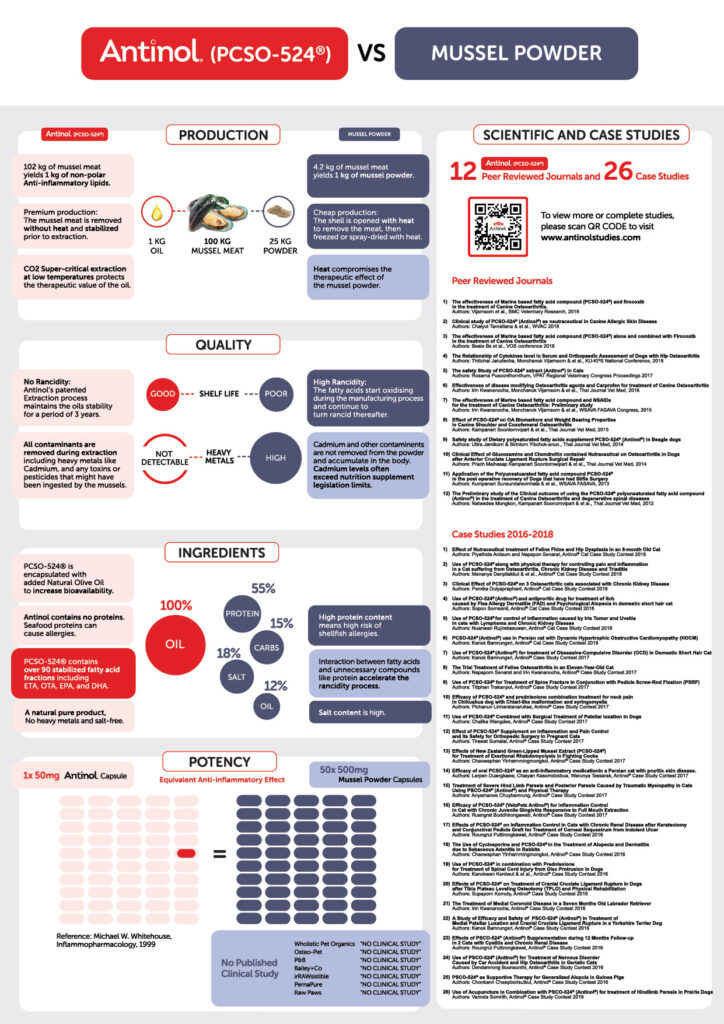

Effect of PCSO-524® Supplement on Inflammation and Pain Control and Its Safety for Orthopedic Surgery in Pregnant Cats

Bone fracture is common in stray cats. It can cause severe pain and requires surgical treatment.
Use of non-steroidal anti-inflammatory drugs (NSAIDs) or opioid drugs is common for control of pain from bone fracture. However, adverse effects are frequently reported for NSAIDs and opioid use.
Objective of this study is to evaluate anti-inflammatory and pain-relieving effects and safety of PCSO-524® (Antinol®) for bone surgery in pregnant cats.


Use of PCSO-524® (Antinol)® for treatment of Obsessive-Compulsive Disorders (OCD) in Domestic Short Hair Cat

A 3 years old domestic short hair cat had shown behavioral disorder after castration 4 months ago.
The clinical signs were consistent with obsessive-compulsive disorders (OCD).
Pathological examination found edema of epidermis andinfiltration of mature mast cells in hair follicle. Treatment with PCSO-524® (Antinol)® for 180 days had shown that the misbehavior was improved due to decreased pain and skin inflammation. Healthier coat and skin appearance was noticed after 30 consecutive days of PCSO-524® (Antinol®) intake. Pathological follow-up showed less inflammation of epidermis and decreased mast cells infiltration.
It was shown that PCSO-524® (Antinol®) could reduce pain and inflammation that caused anxiety and consequently OCD in cats. Additional effects included antihistamine, antiallergy, and skin neurishing.

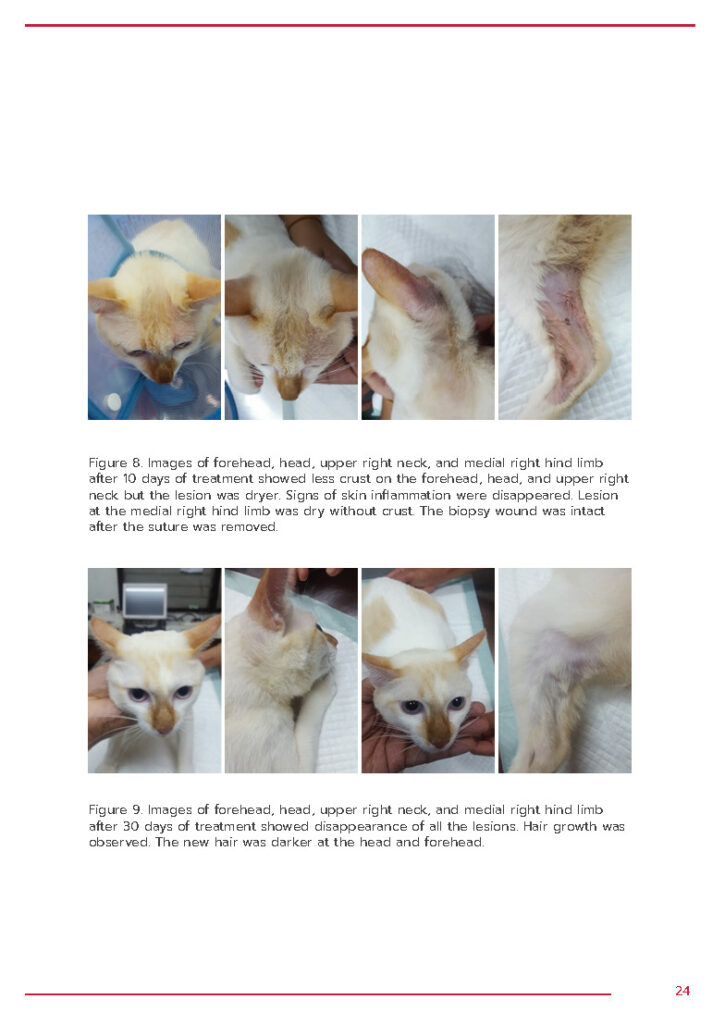
A Study of Efficacy and Safety
of PCSO-524® (Antinol®) in Treatment of Medial Patellar Luxation and Cranial Cruciate Ligament Rupture in a Yorkshire Terrier Dog

Male Yorkshire terrier dog aged 7 years weight 2.5 kg suffered from lameness of left Hind limb.
Examination found medial patellar luxation of grade 3 and chronic cranial cruciate ligament rupture.
PCSO-524® (Antinol®) 100 mg per day, double size of recommended dose for dogs weighed less than 20kg, was prescribed.
Examination of lameness score and pain on palpation showed improvement after PCSO-524® (Antinol®) treatment. Radiographic images taken before and after 45 days treatment with PCSO-524® (Antinol®) did not find progress of the lesion.
Hematological and biochemistry parameters after 45 days treatment with PCSO-524® (Antinol®) indicated that the medication was safe to use.
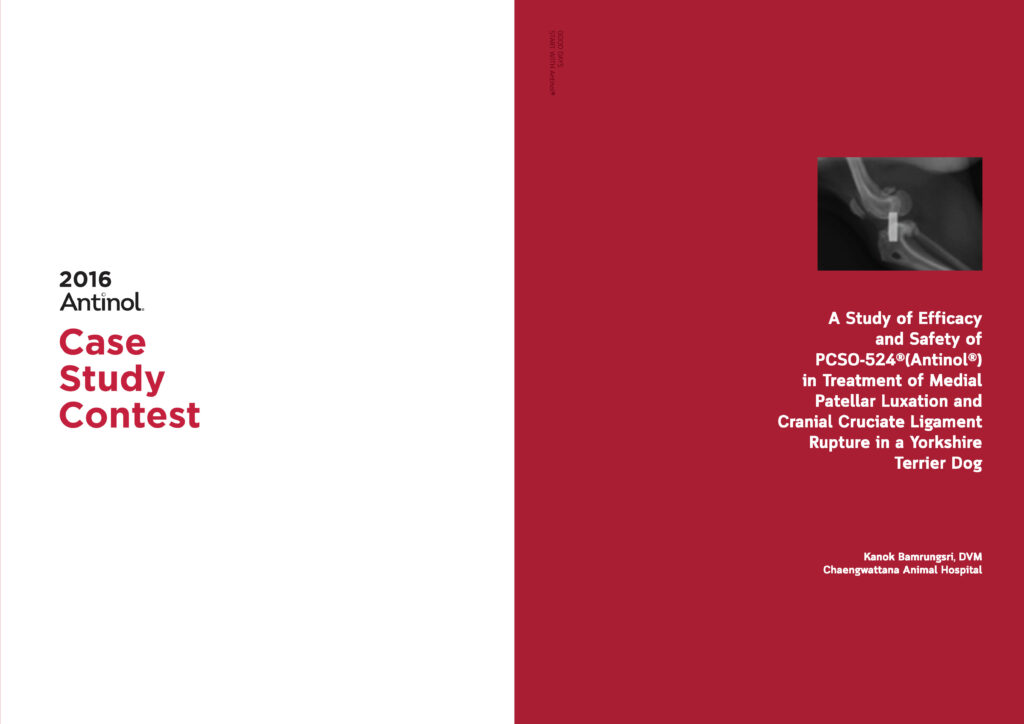
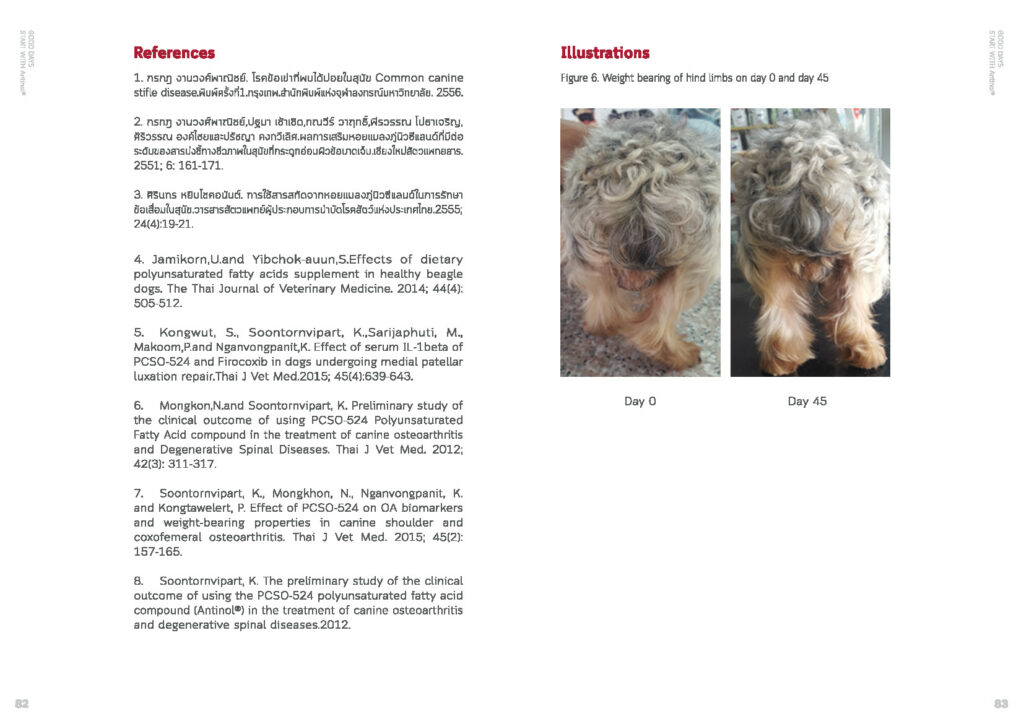
Effects of Dietary Polyunsaturated Fatty Acid Supplement on Healthy Beagle Dogs

A randomized complete blocked design was assigned to 40 healthy Beagle dogs aged between 1 to 3 years old. All dogs were separated into 4 groups, each of which had 5 males and 5 females.
Adaptation and test periods were of 2 and 8 weeks duration, respectively.
Four dietary treatments were composed of basal diet plus 20 empty capsules as placebo (negative control), basal diet plus 2 (the recommended dose), 6 (3 times the recommended dose) and 20 capsules (10 times the recommended dose) of n-3 PUFAs (PCSO-524®: Antinol®).


The Effects of PCSO-524 Extract on Vital Signs, Complete Blood Count, and Blood Chemistry in Clinically-Healthy Normal Cats

Chronic pain is commonly caused by degenerative disease, which is under diagnosed in cats.
PCSO-524 is an extract of Perna canaliculus, a known source of Omega-3 polyunsaturated fatty acids (PUFAs) with anti-inflammatory properties. Lipids extracted from the New Zealand green-lipped mussel (NZGLM) contain a complex mixture of mainly phospholipids (PL, 57-79%), triglycerides (TG, 10-25%), free fatty acids (FFA, 7-12%) and sterols (ST, 12-18%)
PCSO-524 is a source of omega-3 polyunsaturated fatty acids with anti-inflammatory properties commonly used to treat osteoarthritis in human beings and dogs.
The purpose of this study was to study the effects of PCSO-524 extract on vital signs, completed blood count, and blood chemistry in clinically-healthy normal cats.

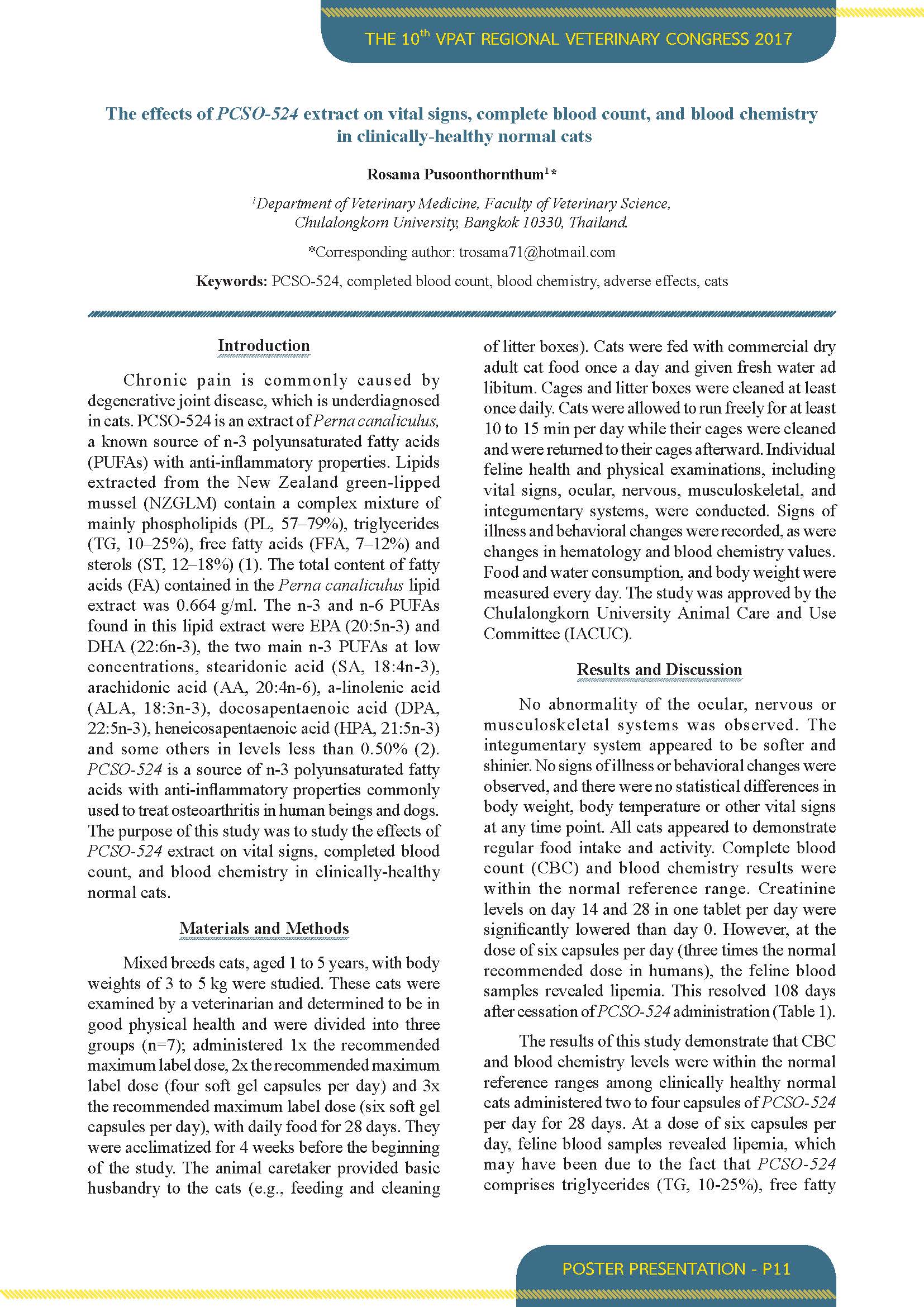
Updated Study Topics
New researches and publications related to PCSO-524® and its result in clnical test submitted by veterinarians on the global conferences every year and the data keeps growing with more studies conducted


 Authors:
Authors: